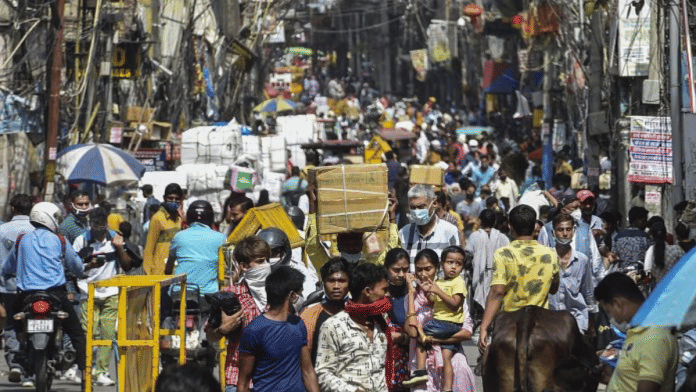New Delhi: India’s fertility rate has come down to 1.9 below replacement levels of 2.1, implying that women in the country are having less children than what is required to maintain its population size.
However, this phenomenon is not unique to India as the United Nations Population Fund (UNFPA) report, ‘State of World Population 2025’, highlights that fertility rates are coming down globally.
“The number of people sharing our planet has more than tripled since 1950, while over that same period, the average fertility rate per woman has declined from 5 in 1950 to 2.25 (UN DESA, 2024),” reads the report released Tuesday.
By 2050, the global fertility rate is expected to reach the replacement level of 2.1.
The report highlights that India was able to slow down its population growth organically via education and awareness.
India’s population stood at 436 million in 1960 with an average woman having six children. However, over the years, access to reproductive healthcare, education and women empowerment helped bring down the fertility rate in India.
“While women in India, and every other country, have more rights and choices today than their mothers or grandmothers did, they still have a long way to go before they are empowered to have the number of children they want – if any – when they want them,” the report states.
India’s population is estimated to have reached 146.39 crore by April and expected to grow to 170 crore before starting to dip in about 40 years, according to the report.
The UNFPA report was compiled after surveying 14,000 people across 14 countries, including India that accounts for 37 percent of global population by YouGov, an international online research and analytics group
It states that two-thirds (68 percent) of India’s population are aged between 15-64 years which is the working age, thereby highlighting its potential demographic dividend. Whereas, people above the age of 65 years are only 7 percent.
The UN report is in line with the National Family Health Survey (NFHS) 5 results stating that India’s fertility rate stood at 2.0 in 2022.
The NFHS highlighted that decline was more prominent in rural areas where the fertility rate stood at 2.1 (3.7 in 1992-93), while in urban areas it came down to 1.6 from 2.7 in 1992-93. Among the states that had fertility rates higher than national average were Bihar (2.98), Meghalaya (2.9), Uttar Pradesh (2.35), Jharkhand (2.26), and Manipur (2.2).
Also Read: What is ‘One state, One Regional Rural Bank’ & why it may be a step in the right direction
Financial limitations are impacting fertility decisions
The report mentions that 51 percent of all Indian women aged between 15-49 years are using contraceptives, while its prevalence rate is 68 percent among married women. 41 percent of women respondents stated that two children should be ideal, while 12 percent women responded having more than two children as being ideal.
The survey also highlights the difference between ideal and expectations. Nearly 7 percent of respondents below 50 years of age state that they expect fewer children than ideal.
The survey asked respondents on the reasons that impact their decision to have fewer children than desired. The answer varies across health, economy, future concerns and family influences.
In India, 38 percent of respondents stated financial limitations as a reason for having fewer children, while 21 percent stated job insecurity or unemployment being a factor. This is not only limited to India, as across 14 nations, 39 percent on average cited financial limitations as the reason for having fewer children.
Family influence plays a key role in women’s decision of bearing children. 19 percent of respondents state “partner” wants fewer children, while 15 percent highlight the reason as partners not providing assistance in household or childcare work.
The role of healthcare professionals was also found to have an impact on underachieving fertility goals. “In India, 14 percent of respondents said pressure from doctors or health workers had led, or would lead, to them having fewer children than they wanted,” the report states.
Udit Bubna is an intern who graduated from ThePrint School of Journalism.
(Edited by Tony Rai)
Also Read: Why flagship PM Internship Scheme is off to a stuttering start with low turnout, high attrition






